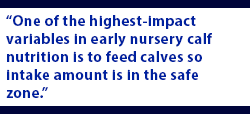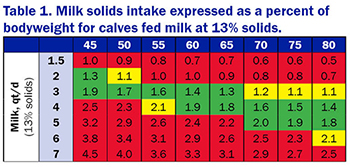
Unique nutrition for Jersey nursery calves
 By Dr. Noah Litherland
By Dr. Noah LitherlandOne key goal of the nursery calf program is to provide an appropriate plane of nutrition (not too high or too low) at the beginning of the nursery phase. Intake amount governs delivery of nutrients, alters rate of passage and impacts microbial communities throughout the gastrointestinal tract.
Expressing intake as a percent of bodyweight is a method used to put intake on a relative basis to make it easier to account for body size when designing or evaluating a nutrition program. Intake as a percent of bodyweight is dynamic during the nursery phase due to:
- Variation among calves’ birth bodyweight
- Variation in rate of growth
- Variation in nutrient intake from both milk and starter grain.
Birth bodyweight of Jersey calves is a significant variable as the range tends to be wide. In a large field study in California, Jersey calf birthweight averaged 65.0 pounds (n = 611), with a standard deviation of 11.9 pounds. (Lago et al., 2018).
 How do you calculate intake as a percent of bodyweight?
How do you calculate intake as a percent of bodyweight?
Simply take the pounds of solid feed intake and divide by the bodyweight of the calf. For example: 1.5 pounds of milk solids divided by 100 pounds of calf bodyweight equals 1.5%. Now that you know how to calculate intake as a percent of bodyweight, you’ll need a basis for comparison.
Table 1 demonstrates how intake as a percent of bodyweight changes with calf size and amount of milk solids fed. Notice the 1.5% of bodyweight in this example would correspond to a 75-pound Jersey calf fed 4 quarts of milk/day at 13% milk solids.

The colors help guide you to a feeding amount that is in the “safe zone” for the calf size you are feeding.
- Green (1.3% to 2.0%) is a safe intake as a percent of bodyweight.
- Yellow (less than 1.1% and greater than 2.1%) requires some caution as it could be too low or too high.
- Feeding in the red zone (less than 1.0% and greater than 2.3%) should get your attention as these feeding rates are too low or too high for the calf size.
Research conducted at Texas Tech University demonstrated the digestive system of a one-week-old Jersey calves is well-suited to digest, absorb, and incorporate protein and energy into growth when fed a high plane of milk nutrition (Lian et al., 2016). Calves fed the high plane of nutrition treatment averaged 65 pounds at birth and were fed at 1.25 pounds of milk solids per day or 1.9% of bodyweight, which fits in the safe zone.
Challenges with over- and underfeeding milk
Field experience and research has taught us that overfeeding milk as a percent of bodyweight will often result in loose manure in calves and potentially compromise intestinal integrity while underfeeding calves will result in slow rate of growth.
Did you notice how the safe zone band widens as the calf gains weight? The intake as a percent of bodyweight is most important for calves during the first two weeks as this is the time they are the smallest and the most sensitive to over- and underfeeding situations.
One of the highest-impact variables in early nursery calf nutrition is to feed calves so intake amount is in the safe zone. Start small calves (50 pounds) at 2 to 3 quarts per day to account for their body size before ramping them up to greater feeding amounts as they gain weight. Read the calf manure to help guide your feeding amounts. If calf manure is too loose, decrease the milk amount to firm up manure to the desired consistency and give calves the balance of growth and health.
Editor’s note: This is the first in a series of articles related to Jersey cow and calf nutrition and management.
About the author: Dr. Noah Litherland is the Vita Plus dairy youngstock technical specialist. He grew up on a diversified livestock farm in central Illinois and was active in 4-H and FFA as a youth. He earned his bachelor’s, master’s and Ph.D. from the University of Illinois, focusing on dairy cattle nutritional physiology. He worked as a dairy extension specialist at Oklahoma State University from 2006 to 2008 and then as a dairy nutritionist at the University of Minnesota until 2014. At Minnesota, Litherland served as the faculty supervisor of dairy research on the St. Paul campus. Read Litherland’s most recent article.
| Category: |
Calf nutrition Dairy Performance |

